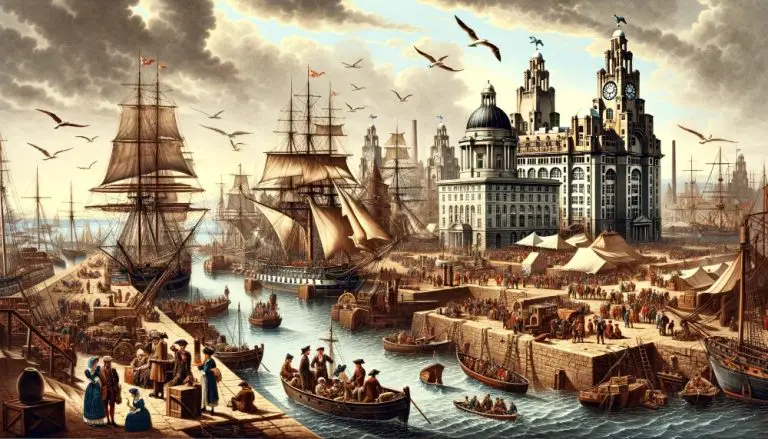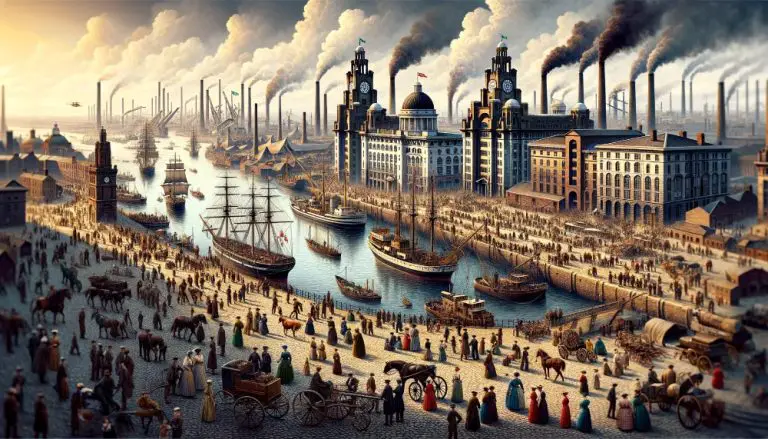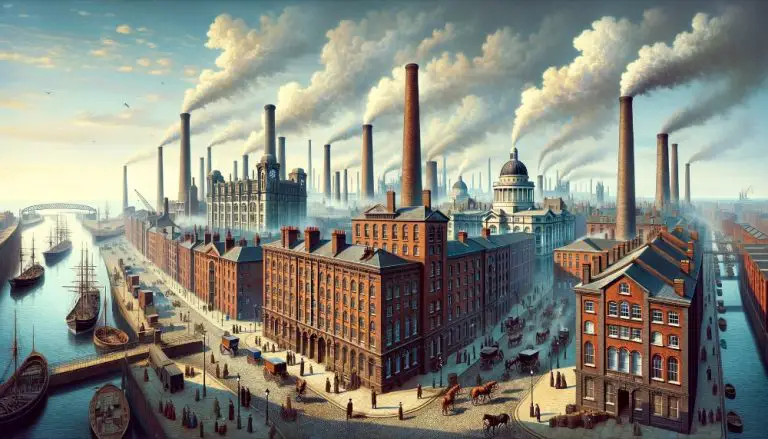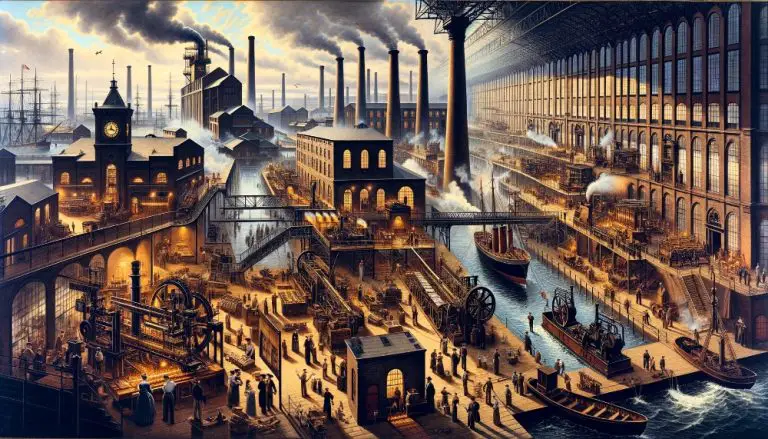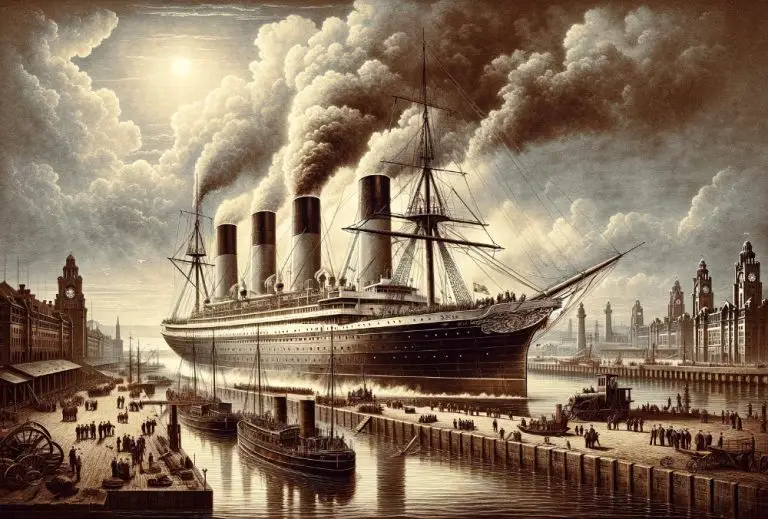First Inter-City Railway: The Revolutionary Liverpool and Manchester Route
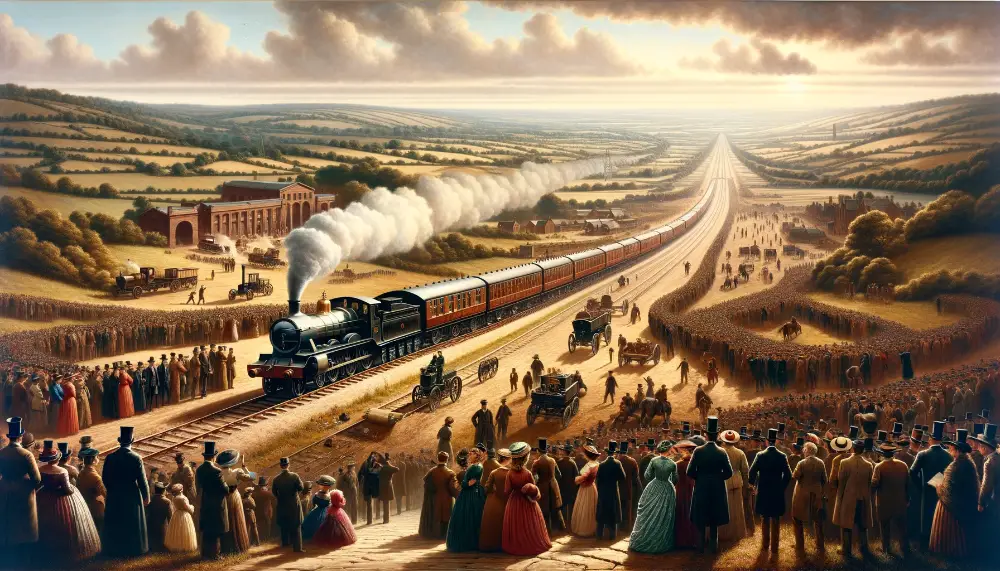
The world’s first inter-city railway – the Liverpool and Manchester Railway. In this article, we explore the construction, impact, challenges, and legacy of this groundbreaking railway that revolutionized transport and trade between two major cities. Let’s journey through history as we uncover the remarkable story behind this pioneering innovation.
Key Takeaways:
- The Liverpool and Manchester Railway was the first inter-city railway, opening in 1830.
- Designed and built by George Stephenson, it relied exclusively on steam-powered locomotives.
- The railway transformed transport and trade between Liverpool and Manchester.
- Construction faced challenges such as opposition from landowners and technical difficulties.
- The opening day of the railway was marred by tragedy, but it continued despite hostility from the crowd.
Construction and Impact of the First Inter-City Railway
The construction of the Liverpool and Manchester Railway, led by George Stephenson, was a monumental undertaking. The railway spanned 35 miles and required the building of 63 bridges across Lancashire’s valleys. The engineers faced numerous challenges in their quest to connect Liverpool and Manchester, including crossing rivers, valleys, hills, and the daunting bog of Chat Moss.
Despite these hurdles, the railway was successfully completed, revolutionizing transport and trade between the two cities. The impact of the first inter-city railway was far-reaching. It provided faster transportation of raw materials and finished goods, boosting the growth of the cotton mills and factories in Manchester. The railway also facilitated the movement of passengers, enabling easier and more efficient travel between Liverpool and Manchester.
The construction of the Liverpool and Manchester Railway played a pivotal role in the development of railways across Britain in the 1830s. Its success demonstrated the potential of railway systems as a means of transportation and encouraged further investment in railway infrastructure. The railway not only connected Liverpool and Manchester but also paved the way for the expansion of railways to other regions, transforming the entire nation’s transport network.
Rare Videos of Liverpool’s Lost Overhead Railway
Impact on Trade and Industrial Growth
The Liverpool and Manchester Railway revolutionized the movement of goods, fueling the growth of trade and industry in the region. The faster transportation of raw materials, such as cotton, and finished goods between Liverpool’s port and Manchester’s cotton mills and factories accelerated industrial production. This led to increased trade activity, creating economic opportunities and driving the prosperity of both cities.
The railway also played a vital role in connecting industrial centers across Britain. It established a crucial link between the port of Liverpool, a major hub for international trade, and the manufacturing powerhouse of Manchester. The efficient transport of goods enabled the distribution of products throughout the country, unlocking new markets and fostering economic development in other regions.
Impact of the First Inter-City Railway on Trade and Industrial Growth
| Impact | Description |
|---|---|
| Accelerated Industrial Production | The railway facilitated the faster transportation of raw materials and finished goods between Liverpool and Manchester, leading to increased industrial output. |
| Boosted Trade Activity | The efficient transport of goods between the port of Liverpool and the cotton mills and factories of Manchester stimulated trade, creating economic opportunities. |
| Integrated Markets | By connecting key industrial centers, the railway enabled the distribution of products throughout the country, expanding markets and fostering economic growth. |
“The Liverpool and Manchester Railway transformed the way goods were transported, revolutionizing trade and industrial growth across the region and beyond.”
Challenges Faced by the Engineers and Inventors
The construction of the Liverpool and Manchester Railway posed various challenges for the engineers and inventors involved in the project. These challenges ranged from opposition by landowners to technical difficulties during the inaugural journey. Overcoming these obstacles required ingenuity, determination, and teamwork.
Opposition from Landowners
One of the primary challenges faced by the engineers and inventors was opposition from landowners. Many landowners were resistant to the idea of a railway passing through their properties. Some even hired thugs to attack surveyors and disrupt the surveying process. This opposition not only delayed the construction but also posed significant legal and logistical obstacles.
Directorial Disagreements
The directors of the Liverpool and Manchester Railway quarreled about the type of locomotive to use. The renowned engineer George Stephenson advocated for steam locomotives, which were still in their early stages of development. However, there were dissenting voices calling for the use of horse-drawn or stationary engines. This disagreement caused delays and uncertainty in the decision-making process.
Technical Difficulties
The engineers and inventors faced various technical difficulties during the inaugural journey of the Liverpool and Manchester Railway. Locomotives derailed and collided, leading to disruptions and accidents. These incidents highlighted the need for further improvements in technology and safety measures. Despite these challenges, the engineers persevered and found solutions to ensure the successful operation of the railway.
“The challenges faced by the engineers and inventors during the construction of the Liverpool and Manchester Railway were significant, but they were met with determination and resourcefulness. These challenges tested their skills and pushed the boundaries of engineering at the time.”
The Liverpool and Manchester Railway stands as a testament to the pioneering spirit and resilience of these engineers and inventors. Their ability to overcome obstacles and find innovative solutions paved the way for the development of railways and transformed travel and trade in Britain.
The Opening Day of the Liverpool and Manchester Railway
The opening day of the Liverpool and Manchester Railway on September 15, 1830, was a momentous occasion for the public. Dignitaries from across the nation, including the Prime Minister, Sir Robert Peel, the Duke of Wellington, and the Austrian ambassador, eagerly boarded the inaugural trains to embark on a historic journey.
The railway tracks were lined with immense crowds of enthusiastic onlookers, eagerly awaiting the sight of the first inter-city trains in action. The air was palpable with excitement and anticipation as the engines roared to life and the carriages began their maiden voyage between Liverpool and Manchester.
“This marks a great achievement in the realm of transportation and trade, connecting our bustling port, Liverpool, to the thriving industrial center of Manchester.”
However, amidst the jubilation of the day, tragedy struck at Parkside railway station. William Huskisson, a prominent politician and Member of Parliament, met a tragic fate as he mistakenly stepped onto the tracks and was struck by George Stephenson’s locomotive, the Rocket. Despite the best efforts of medical professionals in attendance, Huskisson succumbed to his injuries, casting a somber shadow over the day’s proceedings.
Nevertheless, the railway journey persisted, albeit marred by growing tension and hostility from the crowd as it made its way to Manchester. In the face of adversity, the Liverpool and Manchester Railway prevailed, providing a critical stepping stone in the evolution of inter-city transportation and paving the way for the future of railways across the nation.
| Dignitaries | Crowds | Tragedy |
|---|---|---|
| Prime Minister Sir Robert Peel | Huge crowds along the track | William Huskisson fatally injured |
| Duke of Wellington | Eager onlookers | Tension and hostility from the crowd |
| Austrian ambassador | Excitement and anticipation |
The Railway Station and Passenger Travel Experience
The Liverpool and Manchester Railway operated from Liverpool Road Station, serving as the main station for passenger travel on this historic inter-city railway. Here, passengers would book their tickets and wait for their trains in separate booking halls and waiting rooms, providing a sense of order and comfort.
First-class passengers enjoyed a more luxurious experience, with enclosed carriages and upholstered seats, providing a higher level of comfort during their journey. On the other hand, second-class passengers had slower trains and less opulent accommodations, but still benefited from the convenience and efficiency of rail travel.
One noteworthy aspect of boarding the trains at Liverpool Road Station was the absence of platforms. Passengers would scale the carriages from ground level, adding a unique charm to the travel experience. This practice was common during that era and required passengers to be agile and adaptable.
The Liverpool and Manchester Railway revolutionized passenger travel, offering a faster and more affordable means of transportation compared to stagecoaches. This improvement in accessibility and convenience played a crucial role in facilitating trade and connecting communities.
| Passenger Class | Features |
|---|---|
| First Class | Enclosed carriages, upholstered seats |
| Second Class | Slower trains, less luxurious accommodations |
Impact and Legacy of the First Inter-City Railway
The opening of the Liverpool and Manchester Railway had a profound impact on travel and trade. It marked a revolution in transportation, offering faster and more efficient travel between Liverpool and Manchester. The railway transformed trade by providing faster transport of raw materials, finished goods, and passengers between the Port of Liverpool and the cotton mills and factories of Manchester. It also influenced the development of railways across Britain in the 1830s, leading to the construction of thousands of miles of railway tracks.
The Revolutionary Design and Engineering Feats of the First Inter-City Railway
The design and engineering of the Liverpool and Manchester Railway were truly remarkable, spearheaded by the visionary George Stephenson. One of the most notable aspects of Stephenson’s design was the inclusion of four equally spaced rails, a groundbreaking innovation that allowed for the operation of double tracks and ensured the trains could still run even if one of the outside rails was damaged or broken.
This revolutionary design not only enhanced the safety and reliability of the railway but also significantly reduced the amount of land required for its construction. By utilizing four rails instead of the traditional two, Stephenson and his team achieved a remarkable engineering feat that showcased their ingenuity and forward-thinking approach.
But the design of the Liverpool and Manchester Railway was not the only engineering challenge that had to be overcome. The construction of 63 bridges, including those spanning the valleys of Lancashire, required meticulous planning and expert craftsmanship. These bridges were essential for maintaining the smooth flow of the railway across the undulating landscape, providing a testament to the incredible engineering skills of the time.
Additionally, the railway had to navigate various natural obstacles, including rivers and the treacherous bog of Chat Moss. Overcoming these challenges required innovative and resourceful solutions, further highlighting the engineering prowess of George Stephenson and his team.
Overall, the design and engineering feats of the Liverpool and Manchester Railway were not only groundbreaking for their time but also laid the foundation for future railway developments. By pushing the boundaries of what was possible, Stephenson revolutionized the way railways were designed and paved the way for the incredible advancements that followed.
The Role of the Rainhill Trials in the First Inter-City Railway
The Rainhill Trials were a crucial turning point in the development of the Liverpool and Manchester Railway. These trials were a competition organized by the railway’s directors to determine the most suitable locomotive for operating on the newly built railway. Held in Rainhill, a village in Lancashire, England, the trials showcased the capabilities of several steam locomotives and set the stage for the future of railway transportation.
The trials featured five different locomotives, each vying for the opportunity to prove their worth. Among them was the renowned Rocket, designed by Robert Stephenson, son of George Stephenson – the celebrated engineer behind the Liverpool and Manchester Railway. The Rocket’s innovative design and superior performance made it the star of the trials, capturing the attention of both the judges and the public.
With its revolutionary use of multi-tubular boilers, Rocket demonstrated remarkable speed and efficiency, surpassing the performance of its competitors. Its success in the trials solidified the decision to use steam locomotives on the Liverpool and Manchester Railway, forever changing the course of transportation history.
“The Rainhill Trials marked a pivotal moment in the history of rail travel. By showcasing the potential of steam locomotives, these trials paved the way for the widespread adoption of railways as a means of inter-city transportation.”
The Rainhill Trials not only highlighted the capabilities of steam locomotives but also fuelled competition among engineers and inventors. The trials spurred further advancements in locomotive technology, inspiring innovation and leading to the development of faster, more efficient trains.
The success of the Rainhill Trials and the subsequent adoption of steam locomotives on the Liverpool and Manchester Railway transformed the industry. Steam-powered trains revolutionized travel, making it faster, more reliable, and accessible to a wider population. The era of steam locomotion had arrived, marking the beginning of a new chapter in the history of transportation.
The Tragedy and Controversy of the Opening Day
The opening day of the Liverpool and Manchester Railway was marked by a tragic event that cast a dark shadow over the celebrations. William Huskisson, a former cabinet minister, suffered a fatal injury during a stop at Parkside railway station. His untimely death brought sadness and somberness to an otherwise momentous occasion.
As news of the tragedy spread, the Duke of Wellington, who was also in attendance, contemplated canceling the festivities. The atmosphere was filled with an air of mourning and uncertainty.
However, a decision was made to continue the journey to Manchester despite the controversy surrounding the accident. The fear of potential riots and the desire to honor Huskisson’s memory prevailed over the doubts.
As the trains made their way to Manchester, they were met with a hostile crowd. Protesters, fueled by anger and discontent, pelted the trains with objects and directed their grievances towards the Duke of Wellington. The situation was intense and tumultuous, adding another layer of controversy to the already tragic day.
The Success and Expansion of the First Inter-City Railway
Despite the tragedy and controversy of the opening day, the Liverpool and Manchester Railway achieved tremendous success. Within a month of its inauguration, plans were already underway to extend the railway’s reach beyond Liverpool and Manchester, connecting them to other major cities in England. This expansion marked a significant milestone in the growth of the railway network.
The success of the Liverpool and Manchester Railway set the stage for the rapid development of railways across Britain. Over the next ten years, thousands of miles of railway tracks were laid, transforming transportation and facilitating industrial growth. The interconnectivity provided by the expanding railway network paved the way for increased trade, enhanced travel opportunities for passengers, and facilitated the movement of goods throughout the country.
Let’s take a closer look at the expansion of the first inter-city railway with the help of the table below:
| City | Year of Connection |
|---|---|
| Birmingham | 1837 |
| London | 1838 |
| Leeds | 1839 |
| York | 1841 |
This table highlights some of the key cities that were connected to the Liverpool and Manchester Railway in the years following its opening. By expanding the railway network to these cities, the benefits of efficient and reliable transportation were extended to a broader population, further stimulating economic growth and enhancing regional connectivity.
The expansion of the Liverpool and Manchester Railway and the subsequent growth of the railway network in Britain had a profound impact on society. The railways brought people closer together, allowed for the movement of goods on a larger scale, and fostered the development of new industries and markets. This period marked a significant turning point in the history of transportation, ushering in a new era of interconnectedness and progress.
The Opening of a New Era in Transport
The opening of the Liverpool and Manchester Railway marked the beginning of a new era in transport, ushering in the age of mechanized travel. With its introduction, the world was introduced to the possibilities and benefits of railway travel, setting the stage for the development of railways as a primary mode of transportation.
This pioneering railway, often referred to as the Liverpool-Manchester run, revolutionized the way people and goods were transported. It provided a faster, more efficient, and reliable means of travel compared to traditional methods. The railway connected the bustling trading port of Liverpool with the industrial hub of Manchester, transforming the transport landscape in the process.
Industrialist and former British Rail chairman Peter Parker aptly described the significance of this railway, stating, “the world is a branch line of the pioneering Liverpool-Manchester run.” This statement highlights the profound impact that this railway had on global transportation, setting the stage for the rapid development and expansion of railways worldwide.
“The world is a branch line of the pioneering Liverpool-Manchester run.”
The opening of the Liverpool and Manchester Railway marked a turning point in history, propelling society towards a future dominated by mechanized transport. The success and influence of this railway paved the way for further advancements in railway technology and the growth of extensive railway networks across the globe.
Conclusion
The Liverpool and Manchester Railway, renowned as the world’s first inter-city railway, left an indelible mark on transportation and trade. This groundbreaking railway, constructed by the esteemed engineer George Stephenson, completely transformed the way people traveled and revolutionized the cotton mills and factories of Manchester. Its impact went far beyond the immediate region, as it served as a catalyst for the development of railways throughout Britain in the following years.
By showcasing the capabilities and advantages of steam-powered locomotives, the Liverpool and Manchester Railway paved the way for a new era of mechanized transport. The success of this railway not only boosted trade by facilitating the swift transportation of goods and materials, it also provided a faster, more efficient means of travel for passengers between Liverpool and Manchester.
The opening day of the Liverpool and Manchester Railway was a momentous occasion that captured the attention of the nation. However, it was marred by tragedy when William Huskisson, a prominent figure in politics, suffered a fatal accident. Despite this unfortunate event, the railway persevered, demonstrating the resilience and determination of the engineers and inventors involved.
The legacy of the Liverpool and Manchester Railway lives on, serving as a testament to human ingenuity and the power of innovation. It stands as a milestone in the history of transport, shaping the world we live in today by ushering in an era of widespread railway development and transforming the way goods and people are transported worldwide.
FAQ
What is the Liverpool and Manchester Railway?
The Liverpool and Manchester Railway was the world’s first inter-city railway, opening on September 15, 1830. It revolutionized transport and trade between the Port of Liverpool and the cotton mills and factories of Manchester.
Who designed and built the Liverpool and Manchester Railway?
The construction of the Liverpool and Manchester Railway was carried out by George Stephenson, a renowned engineer and inventor.
What challenges did the engineers and inventors face during the construction?
The engineers and inventors faced challenges such as opposition from landowners, technical difficulties, and quarrels about the type of locomotive to use.
What happened on the opening day of the Liverpool and Manchester Railway?
The opening day of the Liverpool and Manchester Railway was a major public event, attended by dignitaries and witnessed by huge crowds. However, it was marred by a tragic incident where William Huskisson, a former cabinet minister, was fatally injured.
What was the main station of the Liverpool and Manchester Railway?
Liverpool Road Station served as the main station of the Liverpool and Manchester Railway.
How did passengers travel on the Liverpool and Manchester Railway?
Passengers booked tickets and waited in separate booking halls and waiting rooms for first and second class. First-class passengers enjoyed enclosed carriages and upholstered seats, while second-class passengers had slower trains and less luxurious accommodations.
What impact did the Liverpool and Manchester Railway have?
The Liverpool and Manchester Railway revolutionized travel and trade, providing faster and more efficient transportation of goods and passengers. It also influenced the development of railways across Britain.
Who led the design and engineering of the Liverpool and Manchester Railway?
George Stephenson led the design and engineering of the Liverpool and Manchester Railway.
What were the Rainhill Trials?
The Rainhill Trials were a competition organized by the Liverpool and Manchester Railway’s directors to determine the best locomotive to use. The famous Rocket, designed by George Stephenson’s son Robert, emerged as the winner.
What controversies surrounded the opening day of the Liverpool and Manchester Railway?
The opening day was overshadowed by the tragic injury of William Huskisson and the hostile crowd present along the route.
How successful was the Liverpool and Manchester Railway?
Despite the challenges faced and the tragic events of the opening day, the Liverpool and Manchester Railway was successful, leading to the rapid expansion of the railway network across Britain.
What was the significance of the Liverpool and Manchester Railway in history?
The opening of the Liverpool and Manchester Railway marked the start of the age of mechanized transport and revolutionized the way people and goods were transported.
What impact did the Liverpool and Manchester Railway have on transport and trade?
The Liverpool and Manchester Railway transformed travel and trade, providing faster transportation of raw materials, finished goods, and passengers between Liverpool and Manchester, as well as influencing the development of railways across Britain.
Source Links
- https://en.wikipedia.org/wiki/Opening_of_the_Liverpool_and_Manchester_Railway
- https://www.scienceandindustrymuseum.org.uk/objects-and-stories/making-the-liverpool-and-manchester-railway
- https://en.wikipedia.org/wiki/Liverpool_and_Manchester_Railway
- The History Behind Liverpool’s You’ll Never Walk Along - February 16, 2024
- The History of Everton FC - February 16, 2024
- The History of Liverpool FC - February 16, 2024

